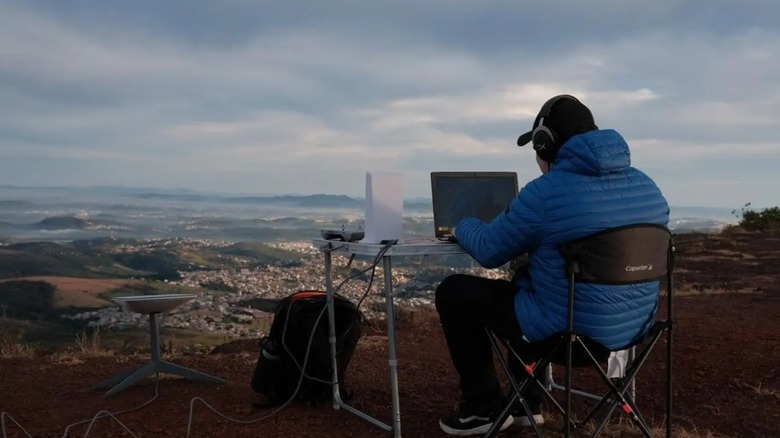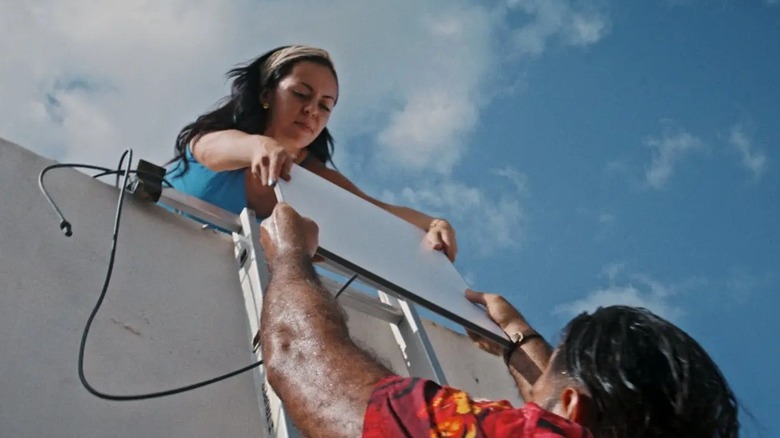Does Starlink Work On Cloudy Days? How Bad Weather Impacts Speeds
One thing that's probably holding you back from moving off the grid and into the countryside is the lack of infrastructure for your internet needs. Fortunately, you now have options like Starlink. Starlink delivers internet to your home via a dish that communicates with the constellation of satellites in space — no need for fixed neighborhood distribution points and long installation cables. All that's required for Starlink to work is the dish, router, power supply, and an unobstructed view of the sky.
This minimal and no-fuss setup is exactly why many people use Starlink while camping or living on a boat, on isolated islands far from cable internet, and even in the middle of nowhere with no Wi-Fi or cellular service. You can easily install the equipment yourself, and it should be ready for use within an hour or so. However, since you'll be installing Starlink outdoors, you might be wondering how well the system fares during cloudy and generally bad weather. Let's find out.
Starlink versus the weather
So does Starlink work when it's cloudy? The short answer is yes. The dish is capable of withstanding the elements and your normal everyday weather with little to no performance drops. According to user reports, they generally don't experience service interruption even if the skies aren't as clear. One user, Sixth Day Ranch on YouTube, even tested Starlink during a thunderstorm with thick clouds overhead and still managed to get a download speed of over 100 Mbps and an upload speed of roughly 20 Mbps. Similarly, TikTok user @maxdestroyer999 tried observing and comparing the Starlink speeds in different weather conditions — clear, cloudy, and light rain — and found that the performance was consistently solid, with speeds of about 200 Mbps.
On snowy days, there also isn't a huge performance hit as the dish comes with a built-in heater to melt the snow. The Standard model can melt up to 1.5 inches per hour, while the High Performance model doubles that speed at three inches per hour. According to @chrisbtech on TikTok, they're still enjoying speeds of 100 Mbps even while it's actively snowing. In terms of temperature and winds, Starlink can be used between -22 °F (-30 °C) to 122 °F (50 °C) and with wind speeds of 60 mph (96 kph) for the Standard model and 174 mph (280 kph) for the Flat High Performance model. Outthereinit on YouTube noted that at -20 °F (-29 °C) in North Idaho, Starlink maintained its usual performance. However, beyond the operating temperatures, expect some sort of degradation.
While the system can operate under somewhat normal conditions, there are still limitations to keep in mind. One of the disadvantages of Starlink is that it can be affected by severe weather. During moderate storms, you might experience temporary slow speeds. Some users report that they lose connection entirely during torrential downpours, but the system comes back online once the rain lets up.
What to do with your Starlink during really bad weather
The Starlink's IP rating — IP67 for the Standard model — makes it so the dish is dustproof and waterproof to a certain degree. This, unfortunately, isn't enough to protect the system during extreme weather conditions like hurricanes and tornadoes. If you happen to experience such natural calamities in your area, Starlink recommends that you remove the dish from its mount, especially if it's on your rooftop, and take it inside, along with the wirings. This ensures that the equipment won't be damaged by flying debris and won't accidentally cause any damage if it comes loose from the mount. You won't be using the service anyway since it will most likely be down during these calamities.
If there's a heavy thunderstorm with frequent lightning strikes, it's best to leave the router and power supply unplugged from the outlet and the dish to protect them. For lightning-prone areas, installing a third-party lightning protector, like a lightning arrester, can also do your system good. Meanwhile, if your Starlink experiences some ice and snow buildup, you can gently pry the icicles from the dish with your hand, not sharp tools like chisels and picks. Snow should easily melt off with the Snow Melt feature, but if it isn't fast enough for your liking, try sliding the snow off the dish (again with your hands only).


